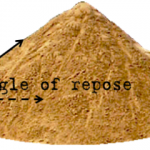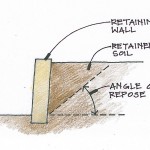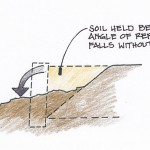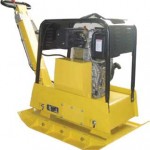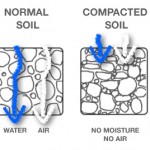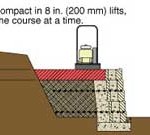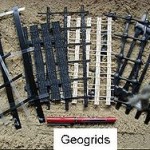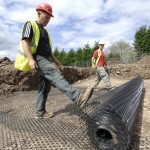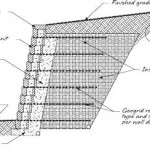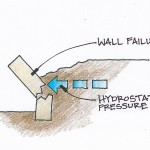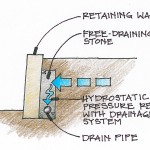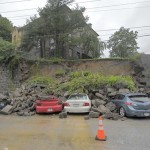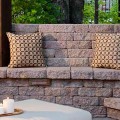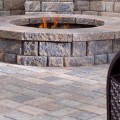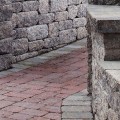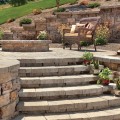
4 Considerations When Building A Segmental Retaining Wall
Segmental retaining walls primarily rely on their weight for stability. They consist of dry-stacked (mortar-free) masonry units and rely on a combination of mechanical interlock and mass to prevent failures such as sliding or overturning. For added stability, the units may also be used in combination with horizontal layers of soil reinforcement extending into the backfill.
Know Your Soil
Understanding the properties of various types of soil is key to building better walls. Different soil types will dictate the amount of time needed for compaction, the amount of reinforcement required, and may help in the estimation of the cost of building the wall. Granular soils, like sand or gravel, are more conducive to the construction of segmental retaining walls as they provide more adequate drainage and will often need less reinforcement. Clay and Silt-heavy sands will require additional care and attention to water management when placed and compacted. Clay is least desireable, as it swells when wet, contracts when dry, and resists compaction. If on-site soils are of low quality under or behind the wall, replace them with stronger soils if possible.
Be aware of the the various angles of repose offered between soil-types, as this value is directly related to a force that is constantly applied to the retaining wall. The angle of repose of a soil-type is the steepest angle of descent relative to the horizontal plane to which a material can be piled without slumping. In other words, this is the angle at which the material on the slope face is on the verge of slumping. Any material added on top of this face will apply force onto the retaining wall. Another way to visualize this is to consider that a retaining wall supports a wedge of soil. This wedge consists of soil that is piled on top of a soil’s angle of repose.
Compaction
The most important step in getting proper compaction is the placement of the soil in “lifts” or layers of less than 2in (50mm). Compaction equipment sizing is dependent upon the type of material being compacted. After each course of block is placed, always backfill and compact. A minimum of two passes with a walk behind plate compactor is required. Start on top of the block, then compact in paths running parallel with the wall to the back of the excavated area. Only walk behind plate compaction equipment should be used within the consolidation zone, which runs from the back of the block back 3ft (.9m) into the infill soil.
Geogrid
Geogrids are composed of synthetic materials, such as polyester yarns, woven into a stable grid network. They improve the structural integrity of soils by reinforcing and confining fill materials and distributing load forces. They are one answer to problems created by a soft subgrade or sloping ground. By increasing the length of geogrid in the wall, you increase the mass of the structure. This essentially means you can build taller walls. However, you cannot increase the mass of the structure by using more layers of geogrid, as this only helps make the mass you are working with act more coherently as a single mass. Generally speaking, geogrid begins to be installed when a retaining wall reaches a minimum height of 3ft, though this is dependent on soil type, pressure behind the wall, and other factors.
Common Modes of Failure
Overturning failure is caused by the force of the soil pushing against the wall. When this thrust exceeds the wall’s weight, failure wil occur. To prevent this, increase the mass of the wall, enlarge the foundation, or use a cantilevered foundation.
Another type of failure caused by the thrust of retained soil can cause the wall to slide away from the backfill when there is shearing failure at the base of the wall. Instead of the wall overturning, the entire unit may slide horizontally. This can be prevented in the same way one may prevent overturning failure.
Unless a wall is designed to retain water or it’s self-draining, proper drainage behind the wall is critical. Drainage materials will reduce or eliminate hydrostatic pressure and improve the stability of the material behind the wall.
The weight of a wall can cause soil to subside or to compress, causing the height of the wall above grade to shrink. This settlement of the foundation can encourage a list of weaknesses. Properly compacting the soil creates a substrate of greater density to act as a foundation for a retaining wall. Building walls on fill soil should be avoided. Walls should be built upon an undisturbed sub-grade. Weak, expansive soils can be strengthened by placing several inches of gravel or a similar material under the retaining wall foundation. Gravel is dimensionally stable and is able to withstand compressive forces generated by the wall structure. Be sure that the gravel base is compacted.

